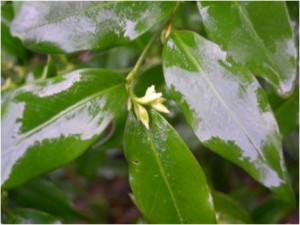 Just because it is winter doesn’t mean that nothing is happening in the garden. While many plants are dormant, their roots and stems are busy feeding the plant until warmer temperatures trigger foliage and bud growth. Some plants have bark that changes color with colder temperatures, like Twig Dogwoods (Cornus spp) or Willows (Salix spp). The bark of some trees, like Birches (Betula spp), become more noticeable in winter as the low light angle highlights it. Golden leaved plants such as Golden Western Cedar (Thuja plicata ‘Techny’ is particularly golden) seem to just gleam in winter’s light. Berries that persist through the cold months also bring color to the garden. Rosa glauca (and some other species roses), Cotoneaster and Ilex are durable berry-bearing plants that brighten up the winter landscape.
Just because it is winter doesn’t mean that nothing is happening in the garden. While many plants are dormant, their roots and stems are busy feeding the plant until warmer temperatures trigger foliage and bud growth. Some plants have bark that changes color with colder temperatures, like Twig Dogwoods (Cornus spp) or Willows (Salix spp). The bark of some trees, like Birches (Betula spp), become more noticeable in winter as the low light angle highlights it. Golden leaved plants such as Golden Western Cedar (Thuja plicata ‘Techny’ is particularly golden) seem to just gleam in winter’s light. Berries that persist through the cold months also bring color to the garden. Rosa glauca (and some other species roses), Cotoneaster and Ilex are durable berry-bearing plants that brighten up the winter landscape.
Winter blooming plants are especially treasured when they add color and fragrance to the landscape. Sweet Box (Sarcocca confusa) has small white flowers that belie their powerfully sweet scent. Plant this one by the front door to enjoy it daily. Viburnum tinus ‘Spring Bouquet’ displays umbels of white flowers from December to March in the Pacific Northwest, and again in late summer. The bright red stems and branchlets against the medium green leaves (evergreen) add contrasting color to the garden, too. Although the threadlike petals of Witch Hazel (Hamamelis spp) may be hard to see from afar, they bloom January to February and some have a spicy sweet fragrance. Hellebores, Primulas, and many spring bulbs start to bloom in late winter. Garden Vision’s landscape designer, Kate Easton, looks forward to the first Daffodil (Narcisus spp) blooms every year.
Some of the plants mentioned in this article are pictured here.
You can also visit the Garden Vision Facebook page to see more pictures.


